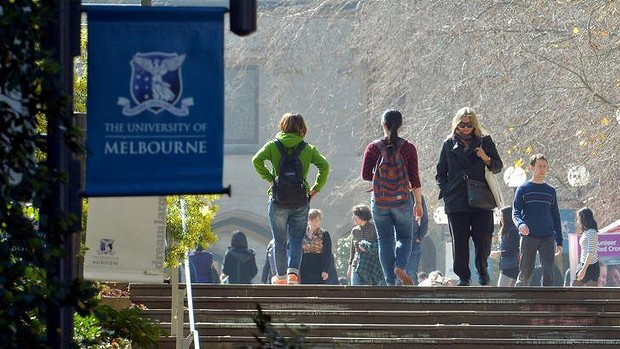Australia’s elite universities could gain hundreds of millions of dollars a year from changes proposed in the federal budget, leaked documents show.
Confidential modelling prepared for university officials suggests Australia’s top universities could reap up to half a billion dollars in one year under the most extreme cases, while regional universities stand to gain far less, sparking fears that the divide between regional and city institutes could widen.
The windfall would flow from legislation expected to be introduced on Thursday by Education Minister Christopher Pyne, which would allow universities to set their own fees.
The government also wants to increase interest rates on student loans and slash course funding by 20 per cent.
The new measures are expected to meet opposition in the Senate.
The modelling forecasts a range of scenarios for a typical university in the “Group of Eight”. That group, which represents Australia’s most prestigious institutes, includes Melbourne and Monash universities.
Other scenarios in the modelling include:
Scrapping nursing schools at Group of Eight universities.
A 25 per cent drop in domestic student numbers and 10 per cent decrease in international students.
Increasing domestic fees to parity with international students.
The confidential briefing, conducted at a forum by LH Martin Institute, presents radical changes to the kinds of programs universities might offer.
It contemplates that elite institutes could ditch nursing schools altogether. The modelling also analyses what would happen if a Group of Eight university refocused its offering towards “low fees and low research effort” degrees, such as business.
In almost every scenario, including those with reduced student figures, the Group of Eight universities enjoy healthy margins. The minimum scenario modelled sees a Group of Eight university nearly $200 million a year better off than the status quo. For some courses, students’ HECS debt could grow to four times current values.
The modelling also looked at a range of scenarios for other metropolitan and regional universities.
The Pilbara Group, which prepared the modelling,stressed that the biggest forecast surpluses might be much smaller in reality
Pilbara Group chief executive Lea Patterson said the presentation was based on “demonstration models”, which were general and did not apply to any particular university.
“The actual results will be dependent on each university’s circumstances,” he said. “One of the key things that came out of it … was that universities don’t have to go to excessive fees to be financially sustainable.”
Mr Patterson said the Group of Eight universities were insulated against some changes in financial circumstances because of their size. “The demonstration models are certainly showing they can weather the storm but what happens in reality? I can’t say.”
The architect of the HECS student loan scheme, Bruce Chapman, has previously suggested university degrees could triple in cost under a deregulated fee system.
Grattan Institute higher education program director Andrew Norton, who attended the presentation, said universities would have to make tough choices about their future.
But he said the modelling showed that universities did not have to “passively” pass on the cost to students of the federal government’s changes.
Mr Norton stressed that some of the scenarios in the modelling were unrealistic but said some of the cost-saving measures were feasible.
He said the Group of Eight universities might take fewer students if they set higher fees for their courses.
“Under fee deregulation they could get the same amount of revenue with fewer students,” he said. “That could be quite good for some of them but not for students who want to go to those institutions.”
However, “second rank” universities could attract high-performing students who fell short of gaining entry to Australia’s top universities, Mr Norton said
LH Martin Institute director Leo Goedegebuure has recently mentioned some aspects of the modelling in his blog. He alluded to setting tuition fees at about $10,000 a year on average to compensate the government’s proposed reduction in base funding.
Regional Universities Network executive director Caroline Perkins said regional universities did not expect to set their fees at the highest level if a deregulated system was introduced.
But she said regional universities were concerned about whether regional students would be deterred from university studies if fees were increased substantially.
Dr Perkins said it would be a major cultural change if many metropolitan students enrolled at regional universities in response to high course fees in the major cities.
“There is the potential for students to look at fee amounts and make judgments based on that. However, in this country we just don’t have a history of students moving long distances to attend university,” she said.
Dr Perkins said “thin markets” outside of metropolitan areas meant regional universities would be unable to charge high fees for their courses.







